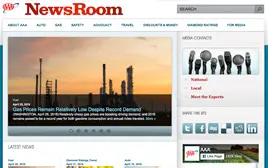Less Expensive Crude, Expected Demand Drop and Winter-Blends Are Driving Down Prices
BELLEVUE, Wash. — When filling-up at the pump this fall, AAA forecasts the majority of drivers in Washington and the West Coast region will find savings of potentially 25-cents/gallon compared to summer. Extremely high regional refinery utilization, healthy levels of gasoline stocks, the expected drop-off in demand after Labor Day and the move to winter-blends will contribute to pushing gas prices even lower. Since Memorial Day, gasoline stocks in the region have held between 31 and 32 million barrels (bbl) while regional refinery utilization averaged over 97 percent, according to Energy Information Administration data. The high refinery utilization rate has pushed gasoline stocks nearly 1 million bbl higher than the beginning of the third quarter in 2018. This combination has already started to push prices down and, even better news, in the event of a supply disruption in the region, the cushion could help to suppress spikes. “Healthy refinery run rates throughout the summer have yielded a surplus of gasoline compared to this time last year,” said AAA Washington Public Relations Manager, Kelly Just. “Combined with cheap crude oil and the post-summer demand slump, retail prices are expected to be a lot cheaper in coming months.” California and Hawaii lead the region with the most expensive year-to-date averages followed by Alaska, Oregon, and Nevada. However, gas prices were significantly cheaper for these states than summer 2018 due to cheaper crude prices. Today, gas is $3.01 or more in all seven states in the region except Arizona.
| State | Year-to-Date Average | 2019 Highest Gas Price Average | 2019 Lowest Gas Price Average |
| California | $3.62 | $4.09 (May) | $3.22 (January) |
| Hawaii | $3.64 | $3.66 (May) | $3.24 (February) |
| Washington | $3.25 | $3.54 (May) | $2.86 (March) |
| Nevada | $3.20 | $3.50 (May) | $2.83 (March) |
| Oregon | $3.10 | $3.43 (May) | $2.73 (February) |
| Alaska | $3.06 | $3.49 (June) | $2.78 (March) |
| Arizona | $2.77 | $3.16 (May) | $2.41 (February) |
Oil Dynamics
AAA forecasts crude prices to range between $50 and $60 per barrel this fall. That is a considerable drop from last fall when prices ranged between $60 and $75. Why so cheap? Current total domestic crude inventories sit at 438.9 million bbl, 31.5 million bbl higher than last year at this time. The continued glut of oil encouraged the Organization of the Petroleum Exporting Countries (OPEC) and its partners to extend their 1.2 million barrel per day (b/d) production reduction agreement through the end of the year. However, so far, reduced supply from OPEC and its partners has not led to a sustained higher price for crude.
As always, hurricane season has the potential to cause declining gas prices to shoot back up. This month, the National Oceanic and Atmospheric Administration predicted that 2019’s Atlantic hurricane season is expected to be above normal, with 10 to 17 named storms, including five to nine hurricanes. The West Coast is less likely to see sharp spikes when a hurricane threatens, as compared to the East Coast.
Boost your Vehicle’s Fuel Efficiency
In addition to cheaper gas prices, there are other ways to save at the pump and boost your vehicle’s fuel efficiency this fall.
According to the AAA Foundation for Traffic Safety, Americans drive an average 11,498 miles per year, and annual per-vehicle gasoline use totals approximately 462 gallons. Poorly maintained vehicles are less efficient and use more fuel. To maintain fuel efficiency for your car, AAA recommends checking the owner’s manual for the recommended maintenance schedule, and keep the following in mind:
Perform required maintenance as specified. Keeping tires properly inflated, moving components adequately lubricated, and ignition and emission systems in good operating condition will help ensure maximum fuel efficiency and extend the life of your vehicle.
- Change engine oil at the intervals indicated by the in-car maintenance reminder system or factory schedule. Use an “energy-conserving” oil that meets the vehicle manufacturer’s specifications.
- Keep tires inflated at the proper pressure. Use the figures on the tire information decal on the driver’s door jamb — not the one molded into the tire’s sidewall. Under-inflated tires reduce fuel economy and can be a safety hazard.
- Check the engine air filter at every oil change. A dirty filter won’t affect fuel economy on a modern fuel-injected car, but it will reduce engine performance.
- Engine spark plugs must be in good condition. Some types last for 100,000 miles, but others need to be replaced more often.
Motorists can find current gas prices along their route with the free AAA Mobile app for iPhone, iPad, and Android. The app can also be used to map a route, find discounts, book a hotel, and access AAA roadside assistance. Learn more at AAA.com/mobile.






